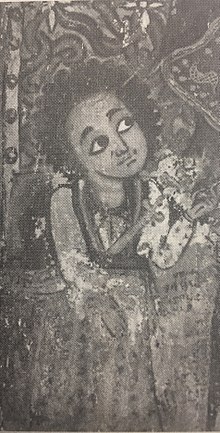Sabagadis Woldu [ሳባጋዲስ ዎልዱ] Error: {{Lang}}: invalid parameter: |links= (help) | |
|---|---|
 A portrait of Sabagadis seeking the intercessions of St. Mary, on the wall iconography at the church of Gunda Gunde, Tigray. | |
| Governor of Tigray | |
| In office 1822–1831 | |
| Preceded by | Wolde Selassie |
| Succeeded by | Wube Haile Maryam |
| Shum of Agame | |
| In office 1810–1831 | |
| Preceded by | Woldu Kumanit |
| Succeeded by | Aregawi Sabagadis |
| Personal details | |
| Born | 1780 Agame, Tigray Province, Ethiopian Empire |
| Died | 1831 Debre Abbay, Ethiopian Empire |
| Parents |
|
Sabagadis Woldu (Tigrinya: ሳባጋዲስ ዎልዱ; horse name: Abba Garray; baptismal name: Za-Manfas Qedus; 1780 – 1831) was a governor of Tigray Province of the Ethiopian Empire from 1822 to 1831.[1] Sabagadis gained some notoriety in the first decade of the 19th century for rebelling a number of times against his overlord, Ras Wolde Selassie. But just before the death of Wolde Selassie it seems that he made up with his master and became one of his loyal lieutenants. Following Wolde Selassie's death in 1816, he defied the authority of Wolde Selassie's son, and became the most powerful warlord in Tigray. Making Adigrat his capital, he ruled Tigray and the coastal plains of Eritrea by 1818.[2] His rule also extended to the Eritrean highlands (Hamasien, Akele Guzay, and Seraye).[3]
- ^ Encyclopaedia Aethiopica. Wiesbaden: Harrassowitz Verlag. 2010. pp. 430–431. ISBN 978-3-447-06246-6.
- ^ Richard K.P. Pankhurst, History of Ethiopian Towns (Wiesbaden: Franz Steiner Verlag, 1982), vol. 1 p. 210.
- ^ Coulbeaux, Jean-Baptiste, Histoire Politique et Religieuse d’Abyssinie: Depuis les temps les plus reculés jusqu’à l’avènement de Ménélik II, 3 vols. (Paris, Geuthner, 1928), pp.381-382.